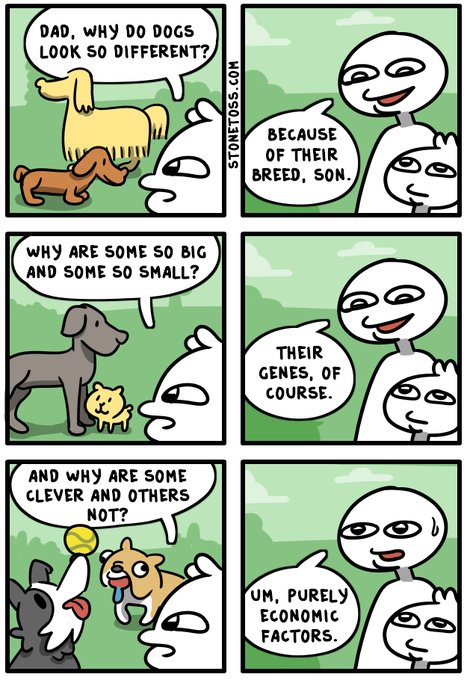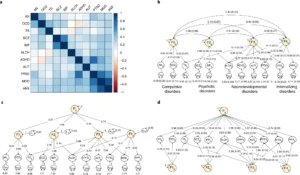I wish to coin a fallacy I’ve seen a number of times, exemplified in this paper:
- Kempthorne, O. (1978). A BIOMETRICS INVITED PAPER: Logical, epistemological and statistical aspects of nature-nurture data interpretation. Biometrics, 1-23.
Abstract:
In this paper the nature of the reasoning processes applied to the nature-nurture question is discussed in general and with particular reference to mental and behavioral traits. The nature of data analysis and analysis of variance is discussed. Necessarily, the nature of causation is considered. The notion that mere data analysis can establish “real” causation is attacked. Logic of quantitative genetic theory is reviewed briefly. The idea that heritability is meaningful in the human mental and behavioral arena is attacked. The conclusion is that the heredity-IQ controversy has been a “tale full of sound and fury, signifying nothing”. To suppose that one can establish effects of an intervention process when it does not occur in the data is plainly ludicrous. Mere observational studies can easily lead to stupidities, and it is suggested that this has happened in the heredity-IQ arena. The idea that there are racial-genetic differences in mental abilities and behavioral traits of humans is, at best, no more than idle speculation.
While explaining the analysis of variance (ANOVA), he writes:
One can find a variety of presentations of analysis of variance which miss this elemental fact. In the heredity-IQ controversy, we see a statement by Feldman and Lewontin (1975) on the nature of analysis of variance that I believe to be totally wrong: “The analysis of variance is, in fact, what is known in mathematics as local perturbation analysis.” In fact, perturbation analysis is a well-defined mathematical-statistical area, and the intersection of that area with the basic idea of the analysis of variance is essentially negligible. They also say “A n analysis would require that we know the first partial derivatives of the unknown function f(G, E).” This illustrates a basic epistemological error. Suppose G and E were real variables and we did know the first partial derivatives; then, so what? They also say “The analysis of variance produces results that are applicable only to small perturbations around the current mean”; again a basic epistemological error. On the matter of the role of variance, to say that additive genetic variance is important “since Fisher’s fundamental theorem of natural selection predicts … ” is wide of the mark, and again exemplifies an error commonly made in population genetics. Fisher’s theorem, if it is correct, deals with fitness, whatever that is (and population geneticists are curiously silent on the matter, using a symbol such as s, and rarely, if ever, discussing the matter of its epistemic correlation to some observation protocol; see, for instance, Kempthorne and Pollak (1970)). It is necessary to my general thesis to bring these matters into the discourse, because understanding of what the analysis of variance does and what it does not do is absolutely critical in the heredity-IQ controversy. These criticisms must not be interpreted to suggest that all of the Feldman-Lewontin paper is suspect.
We now turn to what I regard as a shocking error of logic. Suppose:
so that 80% of the variability is associated with groups. It is all too easy to go from this to the totally erroneous statement that 80% of the variability is due to the factor of classification, where due to is interpreted as caused by. What has gone on in the IQ-heredity controversy is little more than this. It is obvious that this analysis of variance can tell us nothing about causation.
So, Kempthorne is basically just being wordy and saying you can’t just infer causation with mathematical certainty from association in ANOVA. But he goes further than that and says it can tell us nothing about causation. This is plainly false, association is evidence of causation, and depending on context and type of association, can be highly informative or not so informative. Probably a mere correlation in social science is not very indicative of causation (https://www.gwern.net/Causality), but heritability-related statistics are. Since Kempthorne talks about using experiments to establish causation, we use that example against him.
Suppose we are interested in quantifying the degree to which between group means of two subspecies are due to genetic factors versus some other factors. In animals, we can attack this problem using e.g. cross-fostering experiments in which we basically kidnap very young offspring and place them with other parents, which might be from the other subspecies or not; or better yet, we implant embryos to take into account any uterine effects (see this earlier post for discussion of such for humans). Let’s say we are interested in behavior towards humans, e.g. fearfulness. If we do this experiment, we can work out which amount of variance in the trait is caused by rearing by particular parent, by same-group parent, by other-group parent, and by genetics. This kind of thing has been done a lot of times, and in recent times was used to estimate the between group heritability of human friendliness in the Siberian fox experiment. I quote from the book about it (How to Tame a Fox (and Build a Dog), Dugatkin and Trut, 2017):
WHAT LYUDMILA AND DMITRI WERE EQUIPPED TO investigate further was the other ways that innate traits and learning might be affecting their tame foxes. They were constantly availing themselves of the latest techniques for research, and during the time Lyudmila was living at Pushinka’s house, she and Dmitri decided to see whether they could delve even deeper into what degree the behaviors they were seeing in the tame foxes were genetically based.
Even as they tried to hold all conditions constant for the foxes, there were subtle, almost imperceptible differences that could creep into an experiment. For instance, what if the tamest mothers treated their pups differently than the aggressive moms treated their pups? Maybe pups learned something about how to be tame or aggressive toward humans from the way their moms treated them?There was only one way to confirm for certain that the behavioral differences they were seeing between the tame and aggressive foxes were due to genetic differences. Dmitri and Lyudmila would have to try what is known as “cross-fostering.” They’d have to take developing embryos from tame mothers and transplant them into the wombs of aggressive females. Then they would let the aggressive foster mothers give birth and raise those pups. If the pups turned out tame themselves, despite having aggressive foster moms, then Lyudmila and Dmitri would know that tameness was fundamentally genetic and not learned. And, for completeness, they would also do the same experiment with the pups of aggressive mothers transplanted into tame mothers to see if they got parallel results.
In principle, cross-fostering was straightforward; researchers had used the procedure to examine the role of nature versus nurture for many years. But in practice it was easier said than done, it was technically difficult to pull off, and it had worked much better with some species than others. No one had ever tried to transplant fox embryos. Then again, no one had tried lots of things they had done, and so Lyudmila decided she would have to learn this delicate procedure on her own. She read all she could on transplant experiments that had been done in other species, and she conferred with the veterinarians they had on staff. Lives were at stake, so she took her time, learning everything she could.
She would be transplanting tiny, delicate embryos—on the order of eight days old—from the womb of one female into the womb of another pregnant female. Some of the embryos from tame mothers would be transplanted into the wombs of aggressive mothers, and some of those of aggressive mothers would be transplanted into the wombs of tame mothers. When the pups were born seven weeks later, she would closely observe their behavior to see if the pups of tame mothers became aggressive and if the pups of aggressive mothers became tame. But how in heaven’s name was she going to know which pups in a litter were the genetic offspring of the mother and which pups were the ones she had transplanted? Without that information, the experiment was futile. She realized that the foxes had their own unique color coding system. Coat color is a genetic trait, so if she carefully selected the males and females so that the coat coloring of their offspring would be predictable, and the pups of the aggressive mothers would have different colors from those of the tame mothers, she’d be able to tell which pups were the genetic offspring of a female, and which had been transplanted.
Lyudmila led the transplant surgeries with her faithful assistant Tamara by her side. Each surgery involved two females, one tame and one aggressive, each about a week into pregnancy. After lightly anesthetizing the foxes, Lyudmila made a tiny surgical incision in each female’s abdomen and located the uterus, with its right and left “horn,” each of which had embryos implanted in it. She then removed the embryos from one uterine horn and left the embryos in the other. Then she repeated the procedure with the second female. She transplanted the embryos that had been removed from one mother into the other in a drop of nutritional liquid that was placed into the tip of a pipette. “The embryos,” Lyudmila recalls with the pride of a job well done, “stayed outside the uterus [at room temperature from 64 to 68 degrees Fahrenheit] for no more than 5–6 minutes.” The females were then moved to a postoperative room and given time to recover.
Everyone at the Institute anxiously awaited the results. Even with the surgeries having gone so well, the transplanted embryos might not survive. Their wait paid off. It was the caretakers who were the first to discover the births of the first litters, which was often the case with new developments with the foxes. They sent word right away to the Institute. “It was like a miracle,” Lyudmila recorded. “All the workers gathered around the cages for a party with wine.”
Lyudmila and Tamara began recording the pups’ behavior as soon as they left their nests and began interacting with humans. One day Lyudmila watched as an aggressive female was parading around with her genetic and foster pups. “It was fascinating,” Lyudmila recalls, “. . . the aggressive mother had both tame and aggressive offspring. Her foster tame offspring were barely walking but they were already rushing to the cage doors, if there was a human standing by, and wagging their tails.” And Lyudmila wasn’t the only one fascinated. The mother foxes were as well. “The aggressive mothers were punishing tame pups for such improper behavior,” Lyudmila recalls. “They growled at them and grabbed their neck, throwing them back in the nest.” The genetic offspring of the aggressive mothers did not show curiosity about people. They, like their mothers, disliked humans. “The aggressive pups on the other hand retained their dignity,” Lyudmila remembers. “They growled aggressively, same as their mothers, and ran to their nests.” This pattern was repeated over and over. Pups behaved like their genetic mothers, not their foster mothers. There was no longer any doubt—basic tameness and aggression towards humans were, in part, genetic traits.
The house experiment with Pushinka had shown that tame foxes had also learned some of their behavior. Living with humans had taught the foxes additional ways of behaving, some of which they shared with their domesticated dog cousins. Genes surely played an important role, but the tame foxes were not simple genetic automatons; they learned to identify individual people and became particularly bonded to them, and even defended them, owing to the process of living with them. That these learned behaviors were so dog-like provided the tantalizing suggestion that wolves in the process of transforming into dogs might also have learned these behaviors by living with people. Dmitri and Lyudmila had produced some of the best evidence that an animal’s genetic lineage and the circumstances of its life combined in generating its behavior, and had done so in a highly innovative way.
What if you wanted to know about human race groups (populations, subspecies, etc. use your preferred term)? It would be quite cruel to do the above kind of experiments in a controlled fashion, but one can of course investigate adoptions, both within and between populations. For IQ, this has famously been done a few times see: MTAS and Tizard. I have also covered a number of recent studies that no one else seems to have paid attention to (see posts under this tag) until I posted them at which point a paper appeared citing them. Let’s disregard those for now. Suppose we carried out a large number of cross-fostering experiments in many species and for many traits, including cognitive, then we could calculate the summary statistics for these and see if there’s any relations to trait cluster, species type etc. Furthermore, we can relate them to the within group heritability-like statistics. Jensen (1998, p. 445) basically assumes a such relationship holds, though he doesn’t cite any animal research in support:
One of the aims of science is to comprehend as wide a range of phenomena as possible within a single framework, using the fewest possible mechanisms with the fewest assumptions and ad hoc hypotheses. With respect to IQ, the default hypothesis relating individual differences and population differences is consistent with this aim, as it encompasses the explanation of both within-group (WG) and between-group (BG) differences as having the same causal sources of variance. The default hypothesis that the BG and WG differences are homogeneous in their causal factors implies that a phenotypic difference of PD between two population groups in mean level of IQ results from the same causal effects as does any difference between individuals (within either of the two populations) whose IQs differ by PD (i.e., the phenotypic difference). In either case, PD is the joint result of both genetic (G) and environmental (E) effects. In terms of the default hypothesis, the effects of genotype X environment co variance are the same between populations as within populations. The same is hypothesized for genotype X environment interaction, although studies have found it contributes negligibly to within-population variance in g.
Actually, I would expect subspecies differences to be more heritable than within group differences because within group differences have a lot of environmental causal variance in nature, but less in humans because we reduce it by social policies. The average wild adult length of polar and grizzly bears differs by perhaps 50 cm for males (comparisons). But when we rear these bears in zoos, they keep these average differences, indicating that they are due to genetics not environmental habitat-related factors. As for experiments, many people have tried bringing up wolves to be like dogs. This often but not always fails and the wolves end up in wolf sanctuaries. It also often fails for wolf-dog hybrids. There’s actually a published study comparing wolves, poodles and wolf-poodle hybrids, apparently finding them to be quite wolfy in behavior (I couldn’t obtain a complete copy). Another study mentions that wolf-dog hybridization in the wild is quite common in Ethiopia, so one could actually run admixture studies here. I have not search this literature extensively, maybe something great exists waiting to be found by hereditarian-minded researchers.
To return to Kempthorne, the point is that if we can find such relationships between within group heritability-related statistics and between subspecies ones, this would imply that one can indeed derive relevant conclusions. Animal findings generalize to humans to some extent, though, perhaps not as much as we would hope. Given some level of generalizability (prior transfer, we might call it), we might be able to infer a likely range of between group heritability based on within group heritability in humans.
Per this, I shall coin the fallacy made by Kempthorne, which I shall term the deductivist’s fallacy. It is when a critic looks a relationship, finds that he cannot think of any strict formal i.e. necessary/logically necessary relationship between the premises and the conclusion, and then concludes that the premises can tell us nothing about the conclusion. This ignores the fact that the premises may have non-deductive/probabilistic relevance. To put it another way, the deductivist’s fallacy is when one criticizes an inductive argument for not being deductive enough. Many of the traditional fallacies in informal logic can be given a Bayesian reading this way and would no longer be fallacies. For instance, appeal to authority is surely relevant because statements about a topic from experts is more likely to be true than one from non-experts — unless it’s social science! There’s a few papers on this topic such as Korb 2004. Neven Sesardic also has a good discussion of the between/within group heritability reasoning in his excellent book Making sense of heritability.
Related meme



